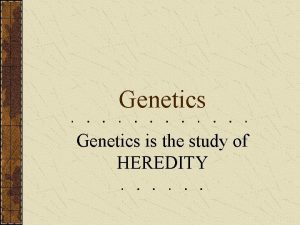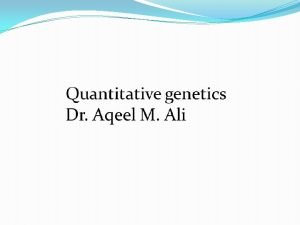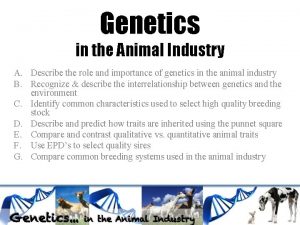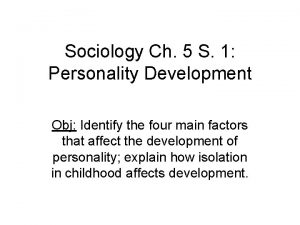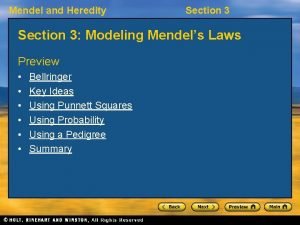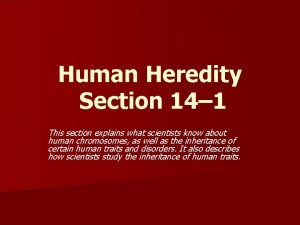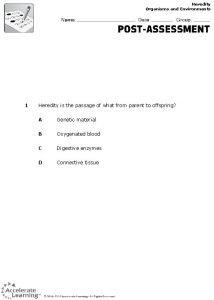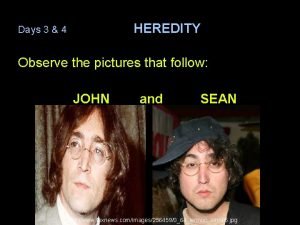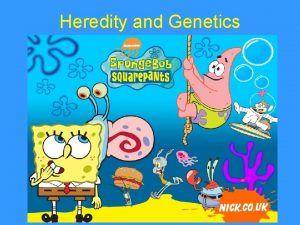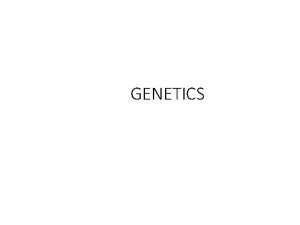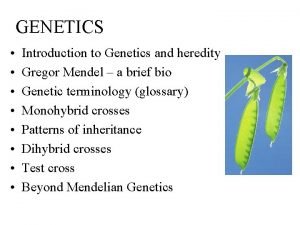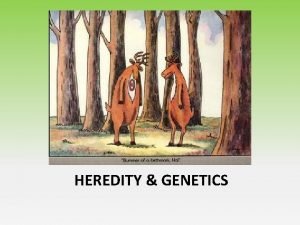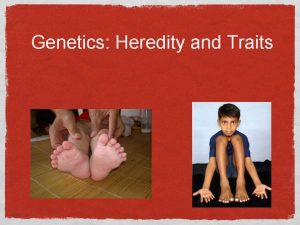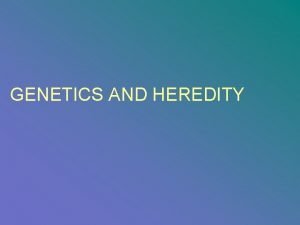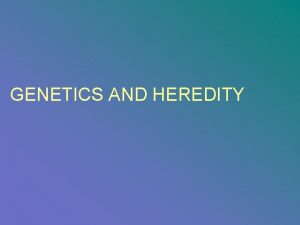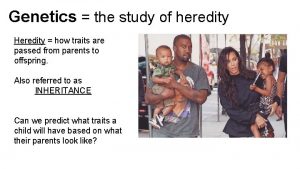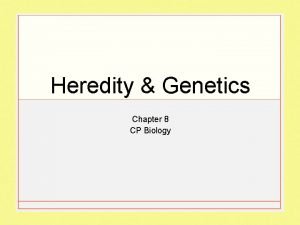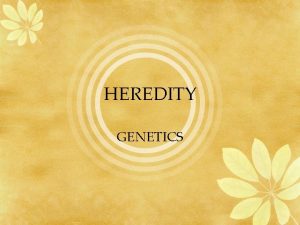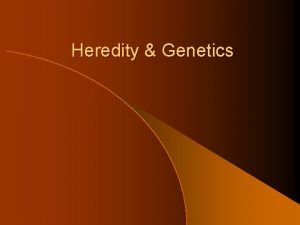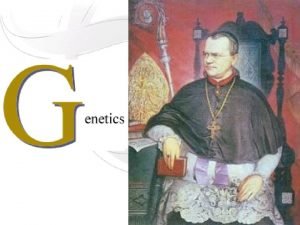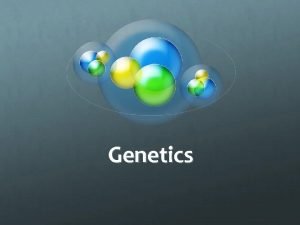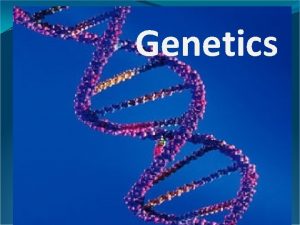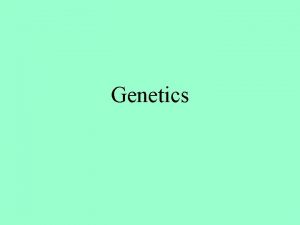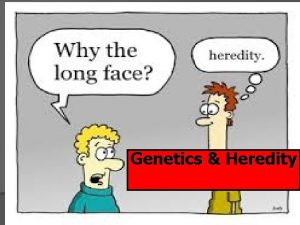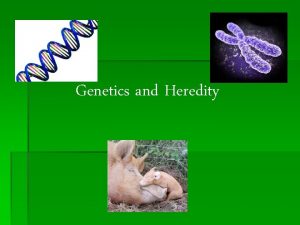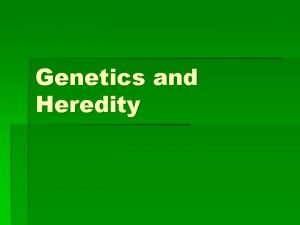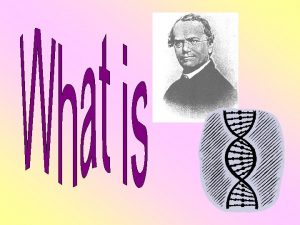Genetics Genetics The study of heredity How traits



















- Slides: 19

Genetics

Genetics • The study of heredity • How traits are passed down through generations • Traits are physical characteristics of an organism (living thing)

Nucleus Animal cell Chromosome GENES DNA

Genes are factors that control traits - found on the chromosome - written as 2 letters either lowercase or capital Alleles- different forms of a gene - written as only 1 letter given by either parent - can be DOMINANT or RECESSIVE

Dominant alleles • Represented by a capital letter Ex: B- brown eyes • The strongest allele • Will always show up on organism

Recessive allele • Represented by a lowercase letter Ex: b- blue eyes • Will only show up if dominant allele is not present • Other parent needs to give a recessive allele in order for it to show up on organism

Possible combinations Trait: eye color Letter representing eye color: E and e E= Brown eyes e=recessive(blue eyes) ****One given by each parent**** Possible combinations: ? ? ? ? _____, ____

Purebred traits • 2 of the same alleles Ex: bb, or BB either 2 dominant or 2 recessive • Also referred to as: homozygous dominant or homozygous recessive

Hybrid traits • Made up of 2 different alleles Ex: Bb – one dominant and one recessive dominant allele always written first - Also referred to as heterozygous

Finding the possible outcome of a trait Law of probability: the likelihood that an event will occur. Punnett square: chart used to show all possible combinations of alleles from a genetic cross.

Family: Mother has homozygous brown eyes and father has heterozygous brown eyes. 1. Decide which is the dominant trait. In this case Brown eyes (B) are (they will usually tell you) therefore, blue eyes are recessive (b). 2. Desegregate data. Homozygous BB Heterozygous Bb 3. Place on chart in appropriate place. Only one letter per box. 4. Bring down letter on top and the one that is on the side for each box. 5. Analyze your findings. 6. 50% homozygous (purebred) dominant and 50 % heterozygous (hybrid) B B (Female) B b BB Bb (Male)

Punnet Square Used to help predict the possibility of offspring receiving a particular combination of alleles from its parents. Each square represents ¼ or 25% chance the parents will produce this type of offspring G GG Gg gg Mother Father

Punnet Square T=tall T t t t=short T

T Tt t t T

T t t Tt T Tt

T t Tt T Tt

t t T T Tt Tt Tt Probability: tall short Tt 4/4 0/4

How do we recognize different traits? Physical & Written Phenotype Sum of visible traits Ex. Color Genotype Alleles that each individual carries. Ex. GG Gg gg

Genotype vs. Phenotype Once you get the possible combinations from the genetic cross, you now have the genotype and phenotype genotype Genotype – genetic make-up BB , Bb or bb Phenotype- physical appearance brown or blue eyes Tall TT Tall Tt Short tt
 Genes is the study of heredity and variation
Genes is the study of heredity and variation Chapter 17 lesson 2 heredity and genetics
Chapter 17 lesson 2 heredity and genetics ____________ is the study of heredity.
____________ is the study of heredity. The scientific study of heredity *
The scientific study of heredity * Inheritance of quantitative traits
Inheritance of quantitative traits Qualitative traits vs quantitative traits
Qualitative traits vs quantitative traits Qualitative traits vs quantitative traits
Qualitative traits vs quantitative traits Chapter 7 extending mendelian genetics
Chapter 7 extending mendelian genetics Brainpop heredity worksheet answer key
Brainpop heredity worksheet answer key Heredity characteristics include body build
Heredity characteristics include body build Heredity concept map
Heredity concept map Section 3 mendel and heredity
Section 3 mendel and heredity 14-1 human heredity
14-1 human heredity Heredity is best described as
Heredity is best described as Pictures of heredity
Pictures of heredity Allele
Allele Heredity
Heredity Homozygous
Homozygous Chapter 11 human heredity section 11-3
Chapter 11 human heredity section 11-3 Chapter 11 complex inheritance and human heredity test
Chapter 11 complex inheritance and human heredity test


